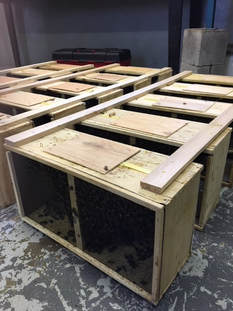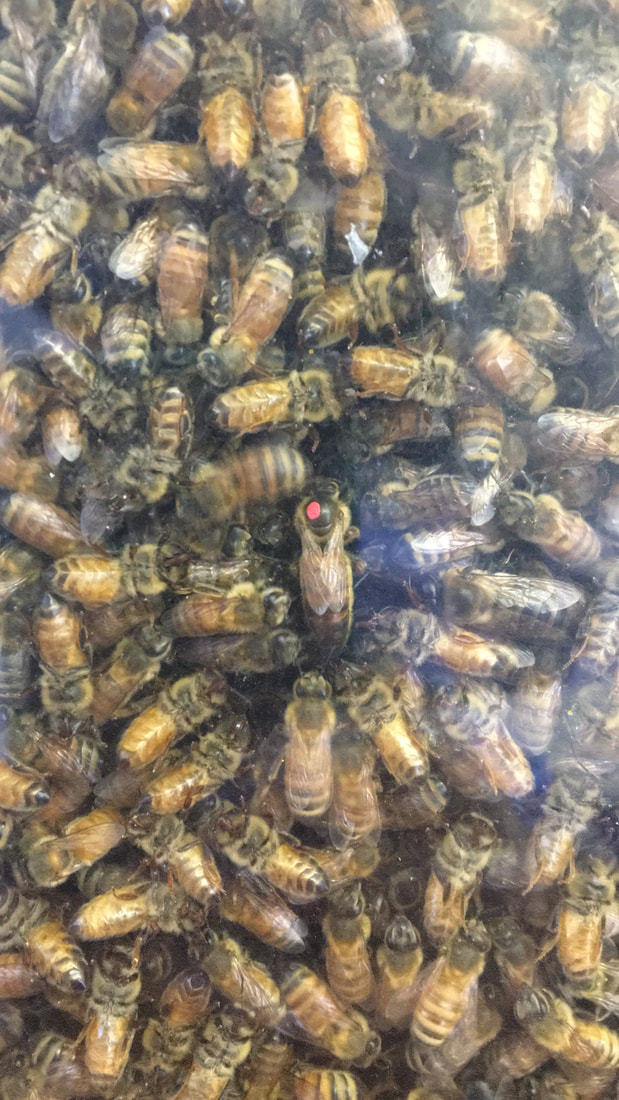|
Last week we finally were able to install our honey bee packages, happily building comb and bees in nucs, into observation hives at our main Blacksburg site. In some ways it's easier to work in a building that already has your nice exit holes drilled. Dr. Roger Schurch and I managed to get all three installed, even though just working with the observation hives gave us some ideas on how we would improve future designs. Here's Roger getting his hands right in the thick of things.  Luckily the bees seemed to settle into their new homes well. The queens were all re-released into the observation hives, and as of this morning, they are all accounted for and laying eggs nicely. You'll notice the brightly colored markings that I painted around all the exit tubes - this is to help homing honey bees find their correct hive. That honey bees can see color was actually first demostrated by Karl von Frisch, who also later correctly explained what was happening in the waggle dance. Back in 1914, it was considered strange that any non-human organism would possess color vision, and yet von Frisch showed that it was occurring in an invertebrate. He did this with a classical conditioning experiment, where he trained bees to collect sugar syrup from a dish placed on a blue card. After training, bees would continue to return and to congregate on the blue card. von Frisch repeated the experiment, but this time, he set the blue card in the middle of differently toned grey cards, one of which matched the blue in tone. If the bees did not see color, they would return equally to the blue and to the matched grey. However, the bees only returned to the blue card. Nowadays it is accepted that bees see color, but back then, this was truly revolutionary. Here is one of our honey bee queens, nicely marked with a red dot in accordance with the International Queen Bee Marking Code (where years ending in 3 or 8 get a red dot).
0 Comments
 Last Wednesday, our bees finally arrived from Georgia. 3 lb packages are shipped in individual boxes, the 14 of which were nailed together. The next morning, I loaded up the truck and headed to Winchester, VA, home to the Virginia Tech Alson H. Smith Agricultural Research and Extension Center (or AREC). This AREC serves Virginia’s commercial fruit and value-added, horticultural food crops, items that usually thought to need pollination services. For this field location, we purchased a shed and outfitted it to house 3 observation hives, seen here (without the bees yet added). The bees could enter and exit their observation hives through PVC pipe that led outside, where we painted markings to help them orient to their proper home. Getting the bees from nucs into the observation hives was a little tricky because it was (still) quite chilly and very windy. We ended up doing the work in the back of the truck I was driving. Once the observation hives were in place, we draped them with micro-fleece duvets (only the best for our ladies) to help them stay warm. Of course, the most important thing to do is to feed them with sugar solution. The honey bees drink the syrup and then generate heat by quivering their flight muscles, work that requires calories. In Winchester, the project is lucky enough to benefit from the expertise and energy of beekeeper and Virginia State Beekeepers Association President Emeritus Rusty Foltz. Rusty will oversee the day-to-day filming of honey bee waggle dances and keep an eye on the observation hives. That's Rusty in the above pictures trimming our wooden frame to fit into the observation hive slots.
Next we'll set up the Blacksburg site and then it is on to Suffolk. |
Archives
September 2019
Categories |








 RSS Feed
RSS Feed
